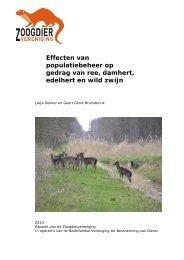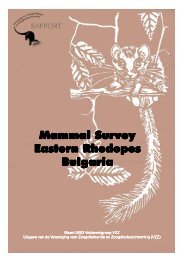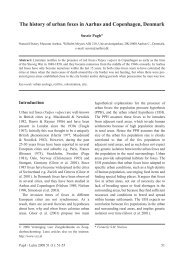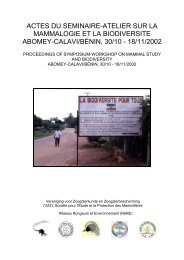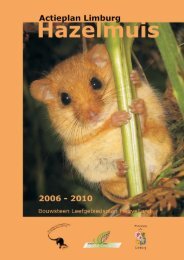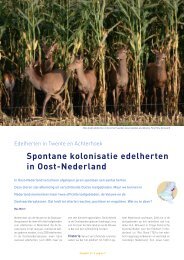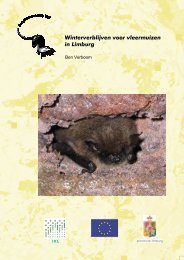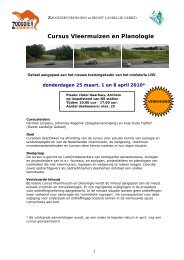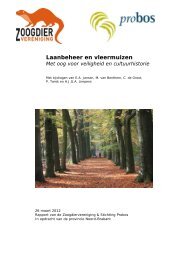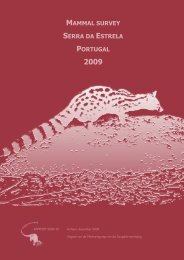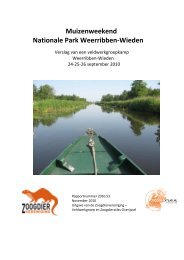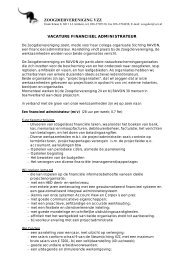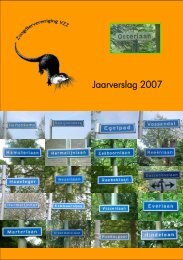Mammal survey Pol'ana - De Zoogdiervereniging
Mammal survey Pol'ana - De Zoogdiervereniging
Mammal survey Pol'ana - De Zoogdiervereniging
You also want an ePaper? Increase the reach of your titles
YUMPU automatically turns print PDFs into web optimized ePapers that Google loves.
On the look for Spermophilus citellus.<br />
European European European souslik souslik ( (Spermophilus ( Spermophilus citellus citellus) citellus<br />
The European souslik proved to be abundant in the Pol’ana region, especially in the grasslands surrounding<br />
the higher altitude areas. In Látky and the nearby village of <strong>De</strong>tvianska Huta large colonies are present. With<br />
a total-population count of the colony closest to our summercamp’s lodge, with about 20 observers<br />
positioned on strategic locations surrounding the population in the middle of the day, 118 individuals were<br />
counted. This total count outnumbered the coincidental counts at the same location – not yielding more than<br />
some tens of individuals – by far. The species seems to flourish in this part of Europe, as a contrast to other<br />
areas. In Slovakia it is present in the whole country except for the higher regions of the north. See also<br />
section 4.4 for more information on souslik tracks.<br />
Water Water vole vole ( (Arvicola ( Arvicola terrestris terrestris) terrestris<br />
In hilly areas like the Carpathians the fossorial type of the water vole is present, living in a mole-like burrow<br />
(Mitchell-Jones et al., 1999). Also in the Pol’ana research area tracks (footprints) of this vole were found.<br />
Field Field vole vole ( (Microtus ( Microtus agrestis agrestis) agrestis<br />
The presence of the field vole is confirmed by several methods: trapping, pellet findings (concerning M.<br />
arvalis or agrestis), as well as the finding of a skull in a nest-like structure in grass. The field vole is probably<br />
quite common in the research area, but is absent in Western and South-eastern Slovakia (Mitchell-Jones et<br />
al., 1999).<br />
Common Common vole vole ( (Microtus ( ( Microtus arvalis arvalis) arvalis<br />
The common vole was observed by several methods. This species proved to by truly common. Next to many<br />
individuals trapped alive there were many findings in owl pellets or pellet debris. One individual found dead<br />
was a fox’s prey. The fox was taken by surprise by the observers and dropped the vole (see also the section<br />
on the red fox below).<br />
Yellow Yellow-necked Yellow necked mouse mouse ( (Apodemus ( Apodemus flavicollis flavicollis) flavicollis flavicollis<br />
Next to captures in live traps (see section 4.1), the presence of yellow-necked mouse is stated by the finding<br />
of a skull. Yet another method, analysis of owl pellets, revealed the jaws of an Apodemus spec. This might<br />
concern A. flavicollis, but other Apodemus species do occur in Slovakia.<br />
<strong>Mammal</strong> <strong>survey</strong> <strong>Pol'ana</strong> (Slovakia) 2005 23<br />
Photo: Rudy van der Kuil



